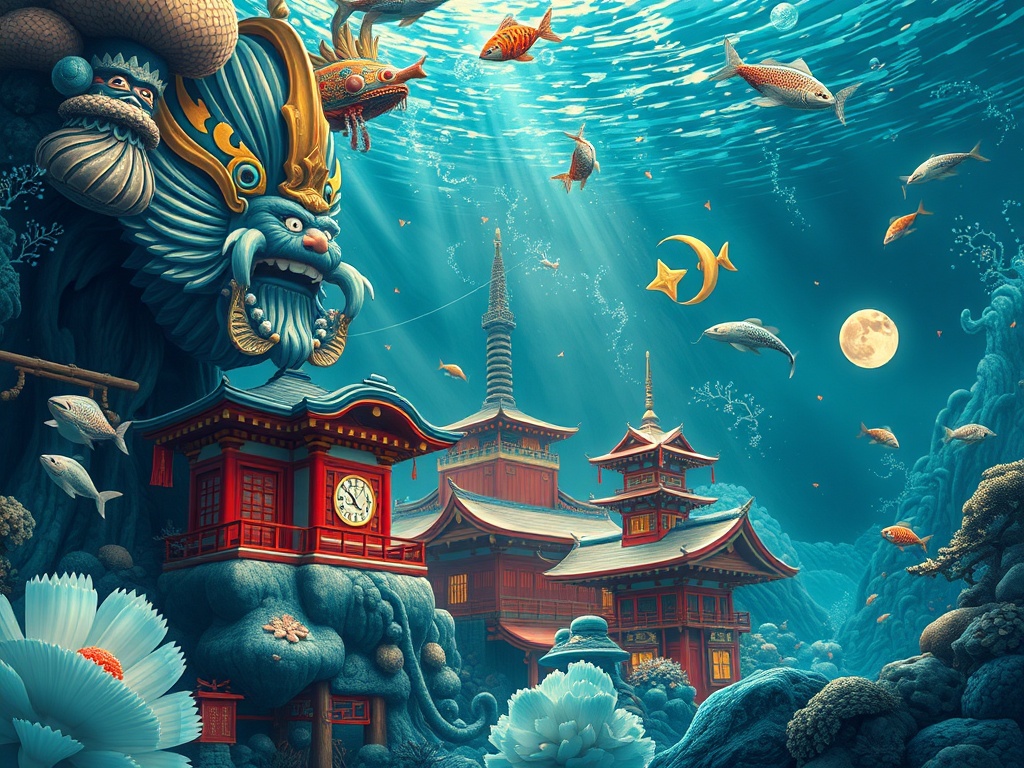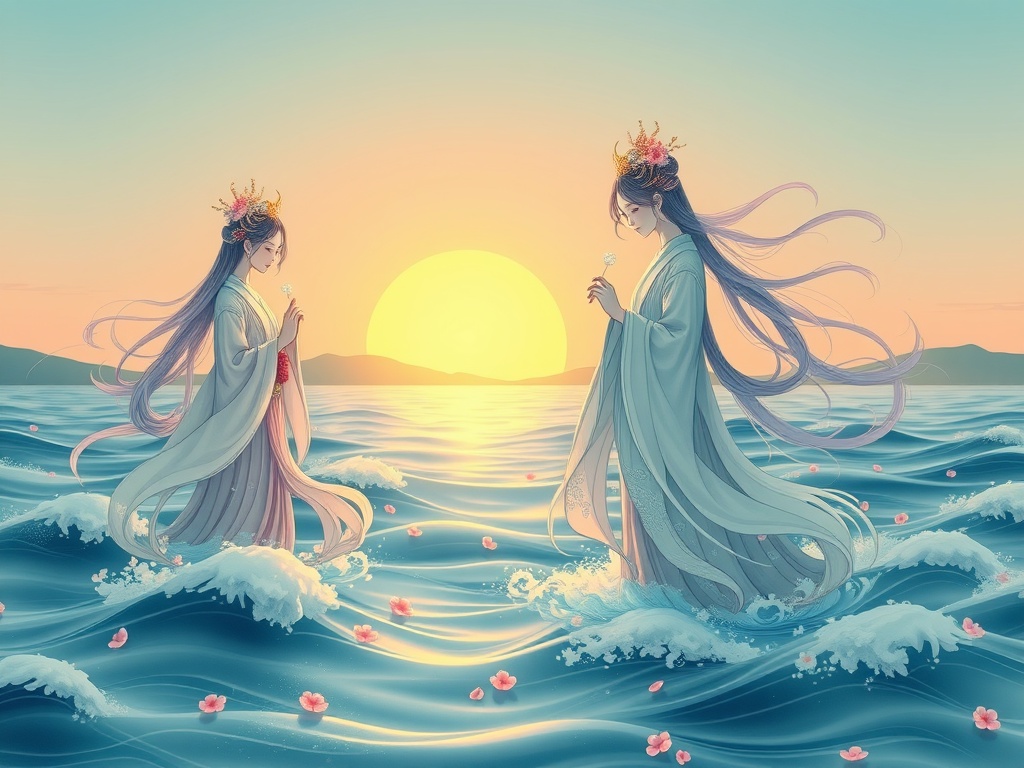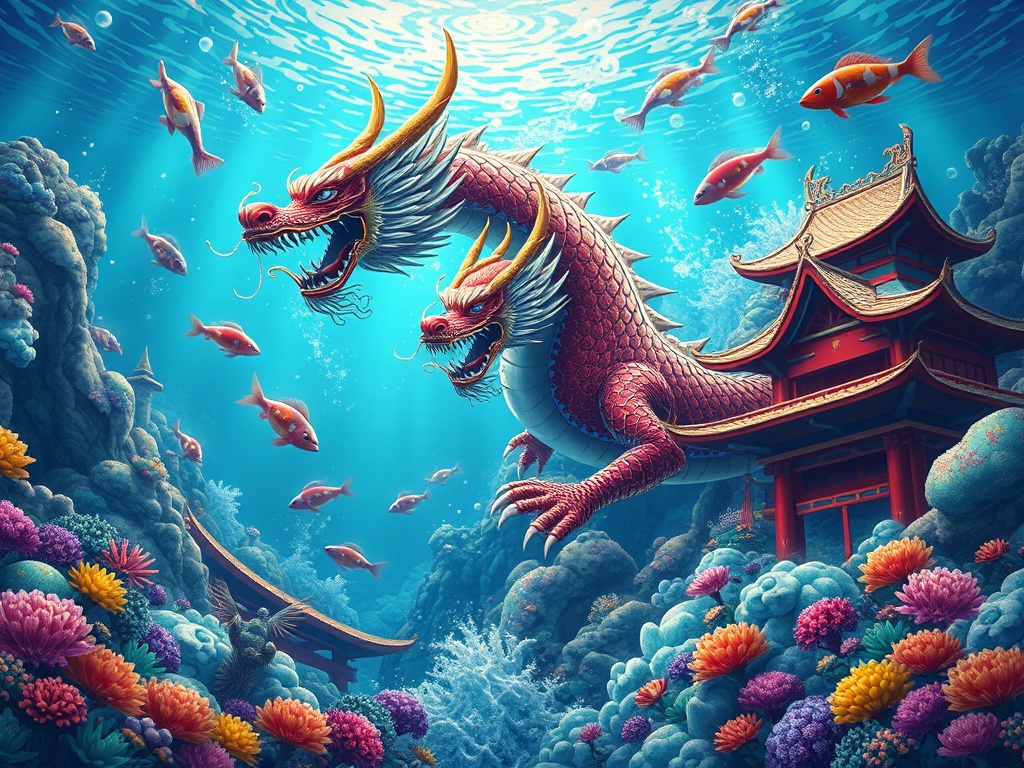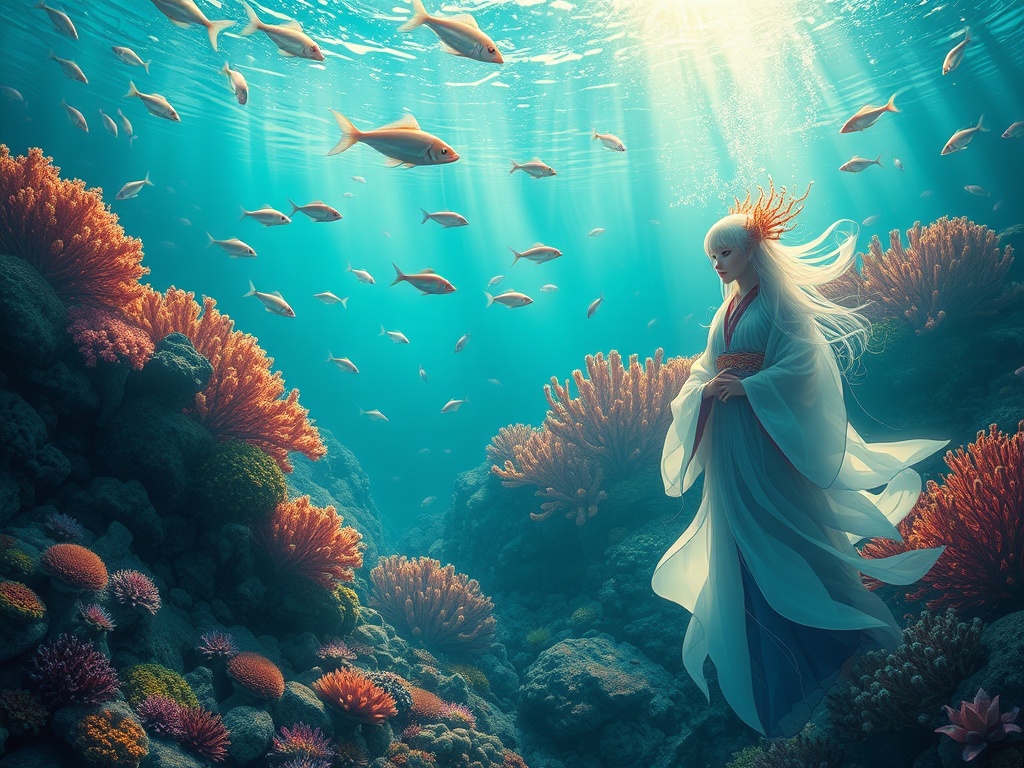Unveiling the Ocean’s Mysteries: The Enchanting World of Japanese Sea Gods
Win a Free Trip to Japan!
Experience cherry blossoms and ancient temples

The vast and mesmerizing oceans that surround Japan have given rise to a rich tapestry of mythology, filled with captivating tales of powerful sea deities. These aquatic gods and goddesses, known for their wisdom and might, have influenced Japanese culture, art, and religious practices for centuries. Join us on an enchanting journey as we delve into the mystical world of Japanese sea gods, unveiling the secrets and legends that have shaped the land of the rising sun.
Owatatsumi, often depicted as a majestic dragon, is revered as the ruler of the ocean depths. Known as the dragon king, he is believed to have control over the tides and the power to calm or unleash the sea’s fury. Travelers visiting coastal regions might feel the presence of Owatatsumi in the rhythmic crashing of the waves or the serene beauty of the ocean at dusk. Discovering the lore of Owatatsumi is a mystical experience, as he is often associated with prosperity, navigation, and protection for fishermen.
Benten, also known as Benzaiten, is the enchanting goddess of everything that flows: water, music, eloquence, and wisdom. As the only female among the Seven Lucky Gods (Shichifukujin), she is often depicted riding a dragon or sea serpent, symbolizing her dominion over the waters. Her shrines are often found on islands, where travelers can appreciate her blessings in the calming sound of water and the harmonious environment. Benten is not only a protector of the sea but also a muse for artists and musicians, inspiring creativity and good fortune.
Noteworthy Shrines and Festivals:
- Munakata Taisha: A grand shrine dedicated to the three Munakata goddesses, including Ichikishimahime, who is associated with Benten. Located on Okinoshima Island, this UNESCO World Heritage site is a must-visit for those seeking a spiritual connection with the sea.
- Sumiyoshi Taisha: One of Japan’s oldest shrines, found in Osaka, is linked to Sumiyoshi Sanjin, the deity of safe sea travel. The shrine’s unique architecture and serene surroundings offer a peaceful respite for travelers.
- Benten Festival: Held annually at Enoshima Shrine, this festival celebrates Benten with vibrant processions, music, and dance, inviting visitors to immerse themselves in the local culture and traditions.
Tidal Tales: Myths and Legends of Japan’s Marine Deities
The ocean is not merely a vast body of water; it is a realm of wonder and mystery, woven with the rich fabric of myths and legends. In Japan, these tales are more than just stories; they are a cultural treasure that connects people to their past and provides insights into the beliefs that shaped their relationship with the sea. As you embark on your journey to explore Japan’s coastal wonders, let the tidal tales of marine deities be your guide, offering a glimpse into the enchanting world where myth and reality intertwine.
Among the pantheon of marine deities, Ryujin stands out as a formidable figure. Known as the dragon god of the sea, Ryujin’s domain is an underwater palace made of coral and crystal. He is a symbol of the sea’s power and unpredictability, capable of summoning storms or granting calm seas. Travelers to Japan’s coastal regions often hear tales of Ryujin’s influence over the sea and the respect fishermen hold for this mighty dragon. The stories of Ryujin emphasize the deep connection between the Japanese people and the ocean, highlighting the importance of nature’s balance and harmony.
One of the most beloved legends in Japanese folklore is the story of Urashima Taro, a humble fisherman who was granted passage to Ryujin’s palace. This tale is not only a captivating adventure but also a timeless allegory about the passage of time and the ephemeral nature of life. Visitors to Japan can immerse themselves in this legend by visiting cultural sites and museums that depict Urashima’s journey, offering a deeper understanding of how such tales have influenced Japanese art and storytelling. Through the tale of Urashima Taro, one can appreciate the profound moral lessons embedded in these ancient narratives.
Embark on a journey through Japan’s coastal regions, where the echoes of these myths can still be felt in the whispering tides and the gentle lapping of waves. Each story, each legend, weaves a tapestry that enriches the travel experience, offering a unique perspective on the way the Japanese view the sea and its deities.
Guardians of the Deep: Understanding the Power and Influence of Sea Spirits in Japan
As you traverse Japan’s coastal landscapes, the presence of sea spirits and guardians becomes an integral part of the journey. These mystical beings, revered through centuries, are believed to embody the essence of the ocean’s mysteries and its formidable power. Their tales, interwoven with the cultural fabric of Japan, reveal a profound respect for the marine world and its custodians, shaping the spiritual and everyday life of those living by the sea.
The concept of sea spirits in Japan goes beyond mere mythology; it is a living tradition that influences maritime activities and coastal communities. From the gentle sea breezes to the fierce ocean storms, these spirits are sought for guidance and protection. One such spirit is Funadama, the guardian of boats and ships. Offerings to Funadama are a common practice among fishermen, who believe her blessings ensure safe passage and bountiful catches. The essence of Funadama’s influence is felt in the rhythmic chants and rituals performed at sea, a testament to the deeply rooted connection between the Japanese people and their maritime environment.
The relationship between the Japanese and their sea deities underscores a delicate balance between humankind and nature. This balance is illustrated through stories of spirits like Suiten, the protector of water bodies. The reverence for Suiten reflects the understanding that the sea is both a life-giving force and a powerful natural element that demands respect. In coastal shrines and festivals, the influence of Suiten is celebrated with vibrant ceremonies, invoking the spirit’s favor for abundant rainfall and favorable tides. Visitors to these events can witness firsthand the harmonious blend of spirituality and tradition, gaining insight into Japan’s enduring respect for the sea’s powerful guardians.
Journey to the Sea: Pilgrimages and Rituals Honoring Japan’s Ocean Deities
Japan’s relationship with the sea is not just one of proximity and necessity but is a profound spiritual connection that has inspired countless pilgrimages and rituals over the centuries. These journeys serve as a bridge between the earthly realms and the mystical domains of the ocean deities, offering travelers a unique opportunity to engage with the sacred traditions that have shaped Japanese culture. As you embark on your own pilgrimage, expect to encounter a blend of breathtaking landscapes, ancient rituals, and a deep reverence for the sea’s enduring mysteries.
Throughout Japan, numerous sacred sites are dedicated to the veneration of sea deities, where pilgrims and travelers alike can experience the spiritual essence of the ocean. One such journey is to the Itsukushima Shrine, located on the mystical island of Miyajima. This revered shrine, dedicated to the goddess Ichikishimahime, offers a captivating blend of nature’s beauty and architectural splendor, with its iconic torii gate appearing to float on the water at high tide. Visitors are encouraged to participate in ceremonial offerings and prayers, seeking blessings from the sea goddess for safe travels and prosperity.
For those seeking a deeper connection, the Kumano Kodo pilgrimage routes provide an immersive experience through ancient paths that traverse the rugged coastal regions of the Kii Peninsula. These routes, recognized as a UNESCO World Heritage site, lead to Shinto shrines and Buddhist temples where travelers can engage in traditional rituals and reflect on the harmonious coexistence between the land and sea.
In coastal communities across Japan, rituals honoring the sea deities are a vital part of life, reflecting a deep-seated respect for the ocean’s power and generosity. The Shio Matsuri or Salt Festival, held in various coastal towns, is a vibrant celebration where participants gather to offer salt to the sea, symbolizing purification and gratitude. This festival is a sensory delight, featuring traditional music, dance, and sumptuous seafood dishes, inviting travelers to partake in the communal spirit of thanksgiving.
Another captivating ritual is the Funadama Ceremony, where fishermen and their families pay homage to the guardian spirit of boats, Funadama. During this ritual, offerings of food and sake are made at sea to ensure the deity’s protection and favor. Witnessing or participating in this ceremony provides a unique insight into the intimate relationship between Japan’s coastal inhabitants and the oceanic forces they revere.
From Waves to Whirlpools: The Role of Sea Deities in Japanese Art and Culture
The captivating influence of sea deities in Japanese mythology extends beyond spiritual practices and into the vibrant realms of art and culture. These revered figures have inspired countless artistic expressions, shaping the cultural landscape and offering travelers a deeper understanding of Japan’s rich heritage. As you explore Japan’s coastal treasures, you’ll discover how these mythical beings have been immortalized in various forms, from traditional paintings and sculptures to modern interpretations that continue to captivate the imagination.
Japanese art has long been a canvas for the mystical allure of sea deities. In traditional woodblock prints, such as those by renowned artists like Hokusai, the ocean’s majestic power is often depicted alongside divine figures like Ryujin and Benten, showcasing their dominion over the watery realms. These artistic masterpieces not only highlight the beauty of the sea but also convey the profound spiritual connection between the Japanese people and their marine deities. For art enthusiasts, visiting museums and galleries featuring these works offers a unique glimpse into the historical significance of these mythological beings.
Contemporary artists continue to draw inspiration from these ancient tales, incorporating elements of sea mythology into modern art forms. From striking sculptures that capture the essence of the ocean’s spirits to innovative installations that invite viewers to engage with the myths on a sensory level, the legacy of sea deities remains alive and vibrant. Exploring these artistic interpretations in cities like Tokyo and Kyoto allows travelers to appreciate the enduring influence of these enigmatic figures on Japan’s cultural identity.
The impact of sea deities on Japanese culture is vividly displayed in the myriad of festivals and performances that celebrate the ocean’s mysteries. Events such as the Nagasaki Kunchi festival showcase dynamic performances and processions that pay homage to the sea’s guardians, blending traditional music, dance, and theater. These festivals offer a sensory immersion into the myths and legends that have shaped Japan’s coastal communities, providing an unforgettable experience for travelers eager to connect with local traditions.
The influence of sea mythology also extends to the world of traditional Japanese theater. Kabuki and Noh performances often feature stories of sea deities, weaving tales of adventure, romance, and divine intervention. Attending a performance at one of Japan’s historic theaters allows visitors to witness the powerful storytelling that brings these ancient myths to life, offering a deeper appreciation for the cultural significance of these sea-bound legends.
Navigating the Divine Waters: How Japanese Sea Gods Shape Coastal Traditions
The enchanting influence of Japan’s sea deities is profoundly woven into the fabric of coastal traditions, guiding the rhythms of life along the shorelines. From the rituals performed by fishermen to the grand festivals that light up coastal towns, these divine figures shape the customs and beliefs of communities living by the sea. As you explore these vibrant traditions, you’ll gain a deeper appreciation for how these mythological beings continue to inspire and protect, offering blessings of prosperity and safety to those who honor them.
In coastal regions, a variety of rituals pay homage to the sea gods, ensuring their favor and protection. The rhythmic chants of fishermen, such as those honoring Funadama, the guardian of vessels, are a testament to the deep respect held for these mystical entities. These chants, often performed before setting sail, are believed to invoke the deity’s blessings for a safe journey and a bountiful catch. Visitors to these coastal areas can witness these sacred practices, gaining insight into the spiritual connection shared between the Japanese people and their oceanic deities.
Another cherished tradition is the offering of salt to the sea during the Shio Matsuri, or Salt Festival. This ritual symbolizes purification and gratitude, reflecting the community’s respect for the sea’s life-giving powers. Participating in these age-old customs provides travelers with a unique opportunity to engage with the spiritual heritage that defines Japan’s coastal culture.
Japanese coastal festivals are a vibrant celebration of the sea’s divine guardians, blending music, dance, and traditional performances. The Benten Festival on Enoshima Island is a dazzling event where the benevolent goddess Benten is honored with lively processions and artistic displays. These festivals not only offer a feast for the senses but also serve as a reminder of the enduring influence of sea deities in shaping the cultural landscape of Japan’s coastal communities.
For those eager to delve deeper into the coastal traditions inspired by sea gods, the Nagasaki Kunchi Festival is a must-see spectacle. This event showcases dynamic performances that pay homage to the sea’s guardians, featuring intricate floats and traditional dances. Attending these festivals allows travelers to immerse themselves in the local culture, experiencing firsthand the profound connection between the Japanese people and their divine maritime protectors.
- Funadama Chants: Rituals performed by fishermen for safe voyages.
- Shio Matsuri: Salt offerings to purify and express gratitude to the sea.
- Benten Festival: Celebrations honoring the goddess of the sea on Enoshima Island.
- Nagasaki Kunchi Festival: Dynamic performances and processions celebrating sea guardians.
Echoes of the Ocean: Discovering Japan’s Underwater Pantheon
Japan’s deep connection to the sea is not only reflected in its cultural traditions and everyday life but also in its captivating underwater pantheon. The myriad of sea deities in Japanese mythology offers a fascinating glimpse into how these divine figures have shaped the nation’s history and continue to influence its coastal regions. Travelers venturing into this mystical realm will find themselves enchanted by the timeless tales and vibrant rituals that celebrate the ocean’s bountiful mysteries.
The ocean’s vast expanse is home to a complex pantheon of deities, each with unique attributes and responsibilities. Owatatsumi, the majestic dragon king, reigns over the sea’s depths, embodying the ocean’s unpredictable power and serenity. His influence is felt in the coastal communities, where fishermen and sailors offer prayers for calm waters and prosperous journeys. Benten, the benevolent goddess of the sea, inspires creativity and artistry, her presence a muse for artists and musicians seeking her divine inspiration. Her shrines, often located on islands, provide a sanctuary of peace and reflection for travelers who wish to bask in her blessings.
Other lesser-known deities such as Watatsumi, the sea god associated with snakes and dragons, and Funadama, the guardian spirit of boats, further enrich the tapestry of Japan’s sea mythology. These deities, though not as prominent as their counterparts, play crucial roles in the seafaring traditions and rituals of coastal communities. Their legends and stories are woven into the everyday lives of those who dwell by the waves, offering travelers a unique insight into the spiritual fabric of Japan.
Embarking on a journey to discover Japan’s underwater pantheon is not merely an exploration of myths but an opportunity to engage with the sacred rituals that honor these deities. The Funadama Ceremony, where offerings are made to ensure safe voyages, is a testament to the enduring respect for these divine protectors. Witnessing such ceremonies provides a profound understanding of the intimate relationship between the Japanese people and their oceanic guardians.
Travelers can also participate in the various festivals dedicated to the sea deities, where vibrant processions and intricate performances celebrate the ocean’s influence. Events like the Benten Festival and Nagasaki Kunchi Festival offer a sensory immersion into the myths and legends that have shaped Japan’s coastal heritage. These gatherings not only highlight the cultural significance of these deities but also invite visitors to partake in the communal joy and reverence that define these celebrations.


